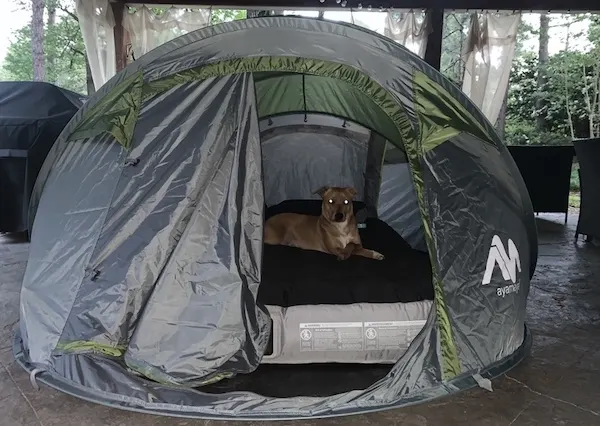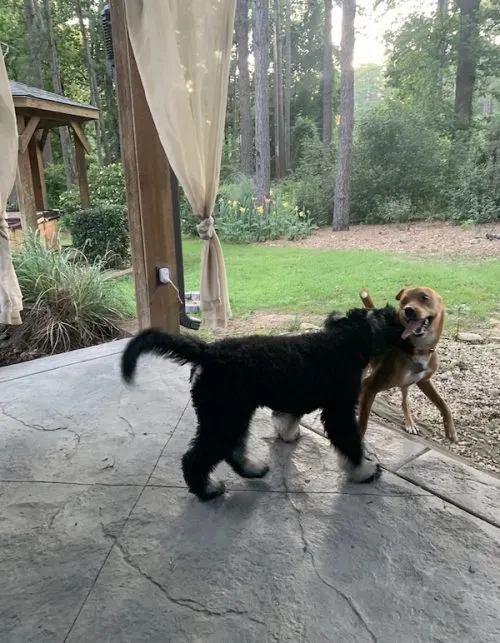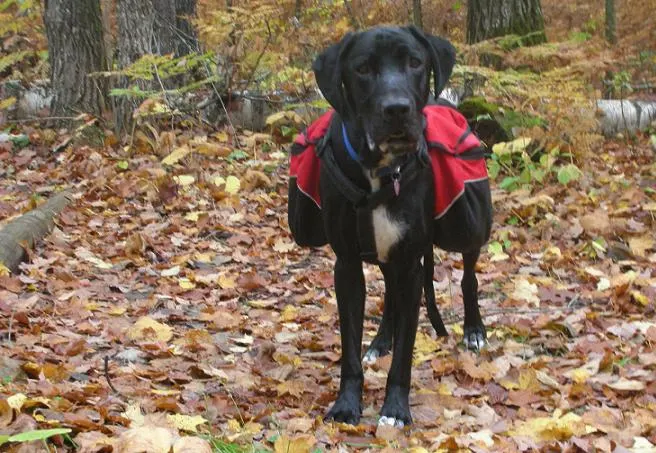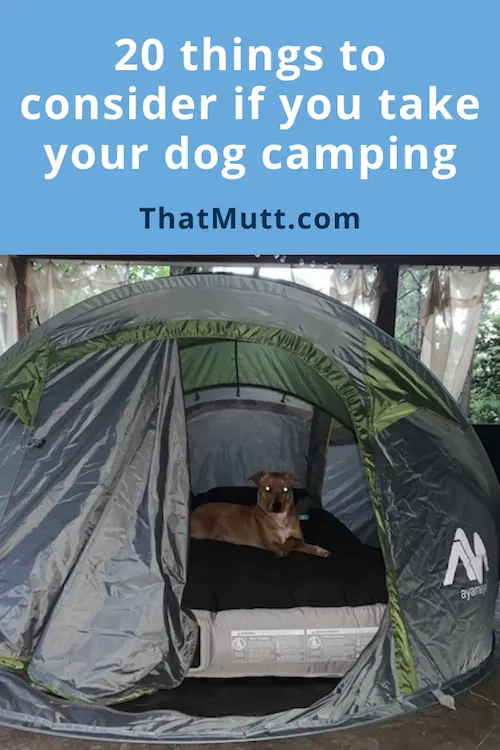One of the great things about owning a dog is taking him places. Of course, there are times when it’s nice to take a vacation away from our pets, but in general, we think it’s great to bring them!
We both like to do a lot of outdoor activities with our dogs, and camping is an option a lot of dogs love! Lindsay’s old dog Ace and now her pup Remy love running, hiking and carrying a pack. Remy is also equally happy to take a long nap inside the tent!
What to consider before taking your dog camping
1. Visit during the off season.
During the off-season, you will find cheaper rates and less people. This is great when you’d prefer to backpack with your dog off-leash or if your dog gets really excited around other people and dogs.
The “off season” will be different depending on where you live and where you are going, of course.
Lindsay has done a lot of camping in the Midwest over Easter, visiting a different park each time and she rarely sees other people.
That’s just not a holiday when people are out camping in that region since it’s usually still cold. She stayed along Lake Superior in Minnesota one fall after the peak foliage season and did not have to deal with anyone else there either.
2. Have your dog carry his own gear.
A dog backpack is perfect. It’s useful, gives your dog a job to do and leaves him tired and out of trouble. You do not want to be hauling your dog’s stuff in your pack if you don’t have to.
Give him something useful to do and have him carry his own food, water and toys. But make sure not to put anything too valuable in the pack like your keys, phone or wallet in case your dog runs off, rolls in something gross or decides to go swimming!
3. Bring extra dog treats.
Treats will come in handy for calling your dog back as needed when he’s off leash or getting his attention in general.
Sometimes other campers are nearby and you may need treats to distract your dog. Your pup might also be burning more calories if you’re doing a lot of hiking or backpacking.
4. Consider the weather.
Lindsay grew up with golden retrievers that could tolerate the cold pretty well, but when she took her Lab mix Ace on his first winter camping trip, he was cold and had to sit in her lap by the fire! A 65-pound dog is no lap dog!
After that, Lindsay always remembered to bring Ace’s vest along, and also an extra blanket for him if it was extra cold. It’s either that or Ace would be trying to crawl into the sleeping bag too!
5. Know the park rules and why they exist.
Almost all parks will require dogs to be on a leash, and that’s if dogs are even allowed at all. Obviously you should pick up after your dog and prevent him from bothering any other visitors, dogs or wildlife.
Unfortunately a lot of National Parks are pretty strict about dogs on trails and camping sites. Many of the state and local parks are more lenient and dog friendly. In the United States, you are typically allowed to bring dogs into National Forrest land and Public Land, but it’s best to check ahead if you’re not sure.
6. Watch your dog at all times when he’s off-leash.
You know your own dog best, but be careful about when and where you allow him off leash.
Lindsay’s dog Ace was a sweet, calm boy who never really wanted to wander off or bother anybody. Her young dog Remy, on the other hand, is a wild child and definitely needs to be leashed at all times unless it’s a very remote campsite.
It’s not worth it to bring your dog without them. If he gets lost and someone finds him, there is no way for that person to contact you.
8. Be ready to deal with mud.
Your tent and gear will probably get muddier just for having your dog along! Same goes with your sleeping bag, car, clothes and everything else!
Mud is probably the least of your worries when camping, but it’s something to keep in mind if you have expensive gear and a clumsy, muddy dog.
9. Get your dog used to a tent at home first.
It’s a good idea to introduce your dog to your tent at home BEFORE you’re ready to call it a night on an actual campsite! That’s exactly what Barbara did with her Feist mix Wally.
She and her boyfriend decided to set up their tent for a night on their patio and see how Wally would do. Worst case scenario would be that Wally didn’t like it, and at that point he still could have slept inside.
Thankfully, Wally LOVED the tent/patio camping experience and slept through the night like a really good boy!
Barbara set him up in his own comfy dog bed right next to the air mattress inside the tent, and he barely moved. Wally’s one of those dogs who doesn’t care much about his surroundings as long as he’s with his people!

10. Socialization is important.
When you’re getting ready to head out on a camping adventure, you’re bound to make a lot of new experiences. You’re likely to run into:
- Other people, including kids
- A decent amount of dogs
That being said, plan ahed and try to expose your dog to new experiences as well as people, kids, and dogs regularly before you leave on your camping trip. It’ll make him much more relaxed on the actual trip, and in return you’ll be able to enjoy it more as well.
You can socialize your pup to nature and other people/kids by taking him hiking at local or state parks.
It’ll also pay off to take him into dog-friendly stores like pet retailers and any others that allow dogs. For example, many home improvement stores likes Lowe’s, Home Depot, and Tractor Supply allow friendly, leashed dogs. Bring high-value treats along and reward your pup for polite behavior with a bite of tasty goodness.
You could also plan doggie playdates with your friends’ or neighbors’ dogs. Alternatively, see about dropping your pup off at a doggie daycare facility once or twice per week.

See ThatMutt’s article: Is Dog Daycare a Good Idea? In this article, you’ll find tips to figure out if a specific daycare is the right one for you and your dog.
11. Bring or have access to lots of water!
Don’t count on streams or running water at parks. Depending on the time of year that you’re planning your camping trip, there may not be any running water at parks and/or campsites.
That’s why it’s important to bring enough water along for yourself and for your pup. The good thing about backpacking with your dog is that he can carry his own water.
12. Prep your dog’s paws if you’ll be doing long hikes/backpacking.
Hiking often happens on rough and/or hot terrain which can be tough on our dogs’ paws, especially when it happens for multiple hours. Doggie paws do much better with shoes or boots when they’re exposed to hot sand, snow, and rocks for an extended amount of time.
We recommend Ruffwear’s Grip Trex all-terrain hiking boots. We also suggest to start getting your dog used to wearing them before you hit the trails, ideally weeks before your trip. That way your pup can get used to the new feeling of covered paws. They’re available on Amazon and retail for $75.00.
Another good option is to bring dog paw cream along with you. It’s a balm that you rub on your dog’s paws before you head out on an extended outdoors adventure.
It provides a shield against hot sand, snow, ice, and rocky terrain. One good option is Musher’s Secret Paw Wax. It’s available on Amazon and retails for $22.00.
13. Endurance – get your dog in shape for hiking, watch for overheating.
Just like us humans need to prepare our bodies for extended outdoors adventures, so do our dogs. A dog who rarely goes on walks and/or hikes will be overwhelmed with that sudden daylong hike.
His paw pads are likely to get cracks that are extremely painful, and he won’t have enough energy to last a full day.
What you don’t want is your pup breaking down in the middle of the woods…otherwise be prepared to carry your (potentially large!) pooch back to your campsite/car!
So in preparation of your trip, take your dog for multiple daily walks as well as at least one hike a week. If you’re planning to have him wear a backpack, get him used to that as well. You can start slowly with having him wear just the empty pack for a week or so. After that, you can add some weight like water bottles, toys, and treats.
Also consider bringing a towel along that you can use to cool your dog down with.
That’s a good solution to avoid overheating if there aren’t any creeks or other bodies of water you can have him stand in or walk through. Simply pour a bottle of water over the towel and use it to wrap your pup’s paws in on a break.
14. Helpful products.
Consider bringing some of the following products along on your camping/hiking trip. They’ll make your life a lot easier:

- Backpack. There are many brands that carry high quality doggie backpacks. Not only are they practical because your dog can carry many of his own things, they also provide both a physical AND a mental workout. We like Ruffwear‘s and Outward Hound‘s packs. Both are available on Amazon and retail between $25-$150.
- Long leash/tether. Long leashes > 10 ft length give your dog more freedom in areas where he needs to be leashed, as well as if he can’t be trusted off-leash quite yet. A tether is great for keeping your pup secure and safe when you have your hands full at the campsite. We’re thinking setting up your tent, preparing food, or just relaxing without having to hold a dog leash non-stop.
- Poop bags. As responsible doggie handlers, we always pick up after our pups! That’s why poop bags are a no-brainer. We love Mighty Paw’s earth-friendly, sturdy poop bags and their poop bag holders. The latter come with a clip that can be attached to anything with a loop – think your own or your dog’s backpack, his leash, your fanny pack, etc.
- Safety belt. The last thing you want is for your dog to go flying through your car if you have to slam on the brakes for whatever reason, or someone else were to hit you. That’s why we always recommend to secure your dog on car trips. Yep, we do it too! Mighty Paw’s car safety belt is our first choice. We are, of course, biased since Mighty Paw and That Mutt are partners 😉
- LED light. Great for low-light and nighttime visibility. Mighty Paw’s LED light easily attaches to your dog’s collar but does require batteries. That’s why it’s a good idea to bring an extra battery along on your trip.
- Travel bowls. Perfect for water breaks for your thirsty pup. Most travel bowls are collapsible and come with a carabiner that easily clips to your dog’s harness or backpack, or your own.
- Dog water bottle. Some dogs don’t like to drink out of water bowls and will much prepare to drink out of water bottle instead! Barbara’s pup Wally, for example, is one of those doggie water snobs. They’re a bit more cumbersome to bring along because they don’t collapse…but whatever works for the pooch, right?!
- Dog sleeping bag. If your trip happens to be during wintertime and your pup has a wash-‘n-go coat, he’ll appreciate a warm sleeping spot, just like us. Ruffwear’s Highlands dog sleeping bag is a great option for that scenario, and retails on Amazon for $140. Another option is to have him crawl into your own sleeping bag, but obviously that’ll depend on your own and your dog’s sleeping preferences.
- Bear bell. If you’ll be hiking through bear territory, this is a great option to make yourself heard.
- E-collar. A good option for off-leash hiking when you want to allow your dog to have some more freedom. Make sure to train your dog to wear an e-collar before you’ll be using it on trips.
- First aid kit. It’s always better to be safe than sorry, so it’s a good idea to bring a first aid doggie kit along. Actually, we recommend two first aid kits: a larger one for your car/campsite, and a smaller one to bring along on hiking or biking and skiing excursions. See ThatMutt’s section What to put in a first aid kit for dogs in our article Ultimate Guide to Dog Safety.
- Tick removal tool. We’ll mention tick (and flea) repellents in section 17 of this article, but sometimes our pups still pick up a tick. For those times, it’s convenient to have a tick removal tool on you like the Tick Twister, Tick Key, or at least some tweezers.
- Extra collars. Nylon collars and even leather ones CAN break or tear, so it’s a good idea to have an extra one handy, such as a chain slip collar.
15. Pack minimal gear if this is a remote backpacking trip.
If you’ll be heading out on a remote backpacking trip, keep the gear you’re taking along minimal. You’ll want water, a tent, a small first aid kit, an extra collar, and food.
16. If you feed raw: dehydrated food for backpacking or a cooler for car camping.
Speaking of food – if you’re a raw feeder, you have two options. Either feed dehydrated, freeze-dried or air-dried raw, or bring a cooler along that holds your pup’s actual raw food. A Yeti cooler has the ultimate cooling power that outlasts all other coolers. However, it does come at a higher price and ranges between $200-$500.
We’re both raw feeders and prefer to bring along actual raw dog food. However, sometimes it’s just more feasible to bring along dehydrated, freeze-dried or air-dried raw, especially when car storage space is limited or you’ll be going on a remote backpacking trip.
Options we like are:
- Ziwipeak (air-dried)
- The Honest Kitchen (dehydrated)
- Grandma Lucy’s (freeze-dried)
- Stella & Chewy’s (freeze-dried)
- Sojos (freeze-dried)
- Dr. Harvey’s (freeze-dried)
- Primal (freeze-dried)
17. Flea/tick prevention for that area.
There are many different options to repel those nasty critters, ranging from sprays to collars, treats, oral and topical ointments. Check in with your vet to see which option might be the most effective/suitable for the area you’ll be camping in, but the following are some options:
- Wondercide Flea & Tick Spray
- Frontline Plus Flea and Tick Treatment (topical)
- K9 Advantix Flea, Tick and Mosquito Prevention (topical)
- Capstar Fast-Acting Oral Flea Treatment (oral)
- Seresto Flea & Tick Collar
- Chewable Flea & Tick Treats
18. Be aware of what wild animals are in the area.
Just like it’s a good idea to see if the area you’ll be traveling to is tick infested, we suggest to familiarize yourself with the wildlife in your area, especially the truly dangerous kind.
Find out if that area is home to bears, mountain lions, bobcats, wolves, coyotes, snakes, spiders, or alligators. The northwestern areas of the US are the most common bear habitat, while alligators are mostly found in the southeast, and venomous snakes are found in every single state except for Hawaii and Alaska.
Our tips for avoiding wild, potentially dangerous animals are:
- Stay on marked trails. Wildlife tends to stay in areas that aren’t busy walking areas.
- Keep your dogs leashed. Dogs are curious by nature and can easily disrupt wildlife if they’re allowed to roam freely.
- Carry a first aid kit on you at all times. Hydrogen peroxide in combination with an antibiotic ointment will come in handy when you need to wash out and treat a wound.
- Wear a bear bell in bear territory. You can attach it to your dog’s harness as well as to your own backpack. Bears don’t like to be surprised, and the noise helps to announce our presence.
For the most part, wild animals want to avoid humans as much as we want to avoid them, but they can display aggressive behavior if they feel threatened in their natural habitat.
19. Research what plants could be an issue – poison ivy, poison oak, poison sumac, blue-green algae.
Likewise, familiarize yourself with local plants that could be dangerous to your dog like:
- Poison Ivy. Found throughout most of the US, except for the desert, Alaska, and Hawaii.
- Poison Oak. Found throughout most of the US, especially on the West Coast.
- Poison Sumac. Predominantly found in the Northeast, Southeast, and Midwestern US, particularly in wet environments like bogs and swamps.
- Blue-Green Algae. Commonly found in stagnant and slow-moving bodies of freshwater like lakes and ponds when it’s hot outside.
Poison Ivy, Poison Oak, and Poison Sumac typically don’t have the same harsh effect on a dog’s skin that us humans experience because of their fur. However, if eaten, they can cause a variety of symptoms ranging from mild to life threatening.
Common symptoms are:
- (Itchy) Rashes, usually on less hairy parts of the dog’s body like the belly and under the legs.
- Gastrointestinal upset like vomiting and/or diarrhea
- Drooling
- Trouble breathing
- Severe liver damage
- Neurological damage that can cause seizures, disorientation, and collapse
What to do if your dog got into Poison Ivy/Oak/Sumac:
- Wash your dog with fresh water and a mild dog shampoo, alternatively spray him down with hydrogen peroxide (put some in a spray bottle). Make sure to wear gloves so your skin doesn’t come in contact with the plant’s toxic oil urushiol.
- Give him the anti-inflammatory Benadryl 2-3 days per day (1 mg of Benadryl per lb of dog, so a 50 lb dog can have two (2) 25 mg pills of Benadryl).
What to do if your dog drank water infected with the toxins from blue-green algae:
- This can be life threatening, so it’s important to get him to a vet right away. That’s why it’s really important not to let him drink from stagnant bodies of water and to bring plenty of bottled water along.
20. Keep your trash and food waste away from your campsite
This precaution will keep wildlife away from your tent. Maintain a distance of at last 300 feet between your trash/food waste and your sleeping area.
Likewise, don’t let your dog chew on doggie bones near your tent, nor feed him where you sleep. Instead, only offer treats, chews, and food where you eat yourself, and make sure to properly bag/pack all leftovers or trash.
The last thing you want is a visit from a bear who thought your pup’s bully stick smelled delicious!
Now we’d like to hear from you!
What tips would you add to our list?

Let us know in the comments!

Sharon Wollenberg
Wednesday 15th of February 2012
I have gone camping with my Goldens before but not in the winter. I give you a lot of credit going camping in the cold, especially North Dakota. I have a 2 dog backpacks now and I just love them. It's great for high energy dogs and really does tire them out. Great blog Lindsay!
Lindsay Stordahl
Thursday 16th of February 2012
Oh gosh, I LOVE dog backpacks! Best idea ever! Thanks for reading!
Tawna
Tuesday 25th of March 2008
What a beautiful place! Those are all good points. Since my dog Emma is aggressive with other dogs it's impariative that I camp/hike in very remote areas in order to maintain my peace of mind in order for BOTH of us to enjoy the vacation. Otherwise I spend the whole weekend disciplining my dog and we both get stressed out.
Lindsay Stordahl
Tuesday 25th of March 2008
Including a different number other than your own on your dog's ID tag is a great idea, especially while camping. Thanks!
Abbey
Tuesday 25th of March 2008
Thanks for the link Lindsay, I went googling and can buy them here in Oz...
Abbey's last blog post..Day Bed
kabbage
Monday 24th of March 2008
On the ID thing, make sure you put a tag with a phone number that will be attended, even if it's not your usual number. If you are out camping, I suggest using the phone number of someone who is *not* with you, as well as your cell phone number. You might be out of range for the cell, not have a place to charge it, or whatever.
kabbage's last blog post..Sleek Update